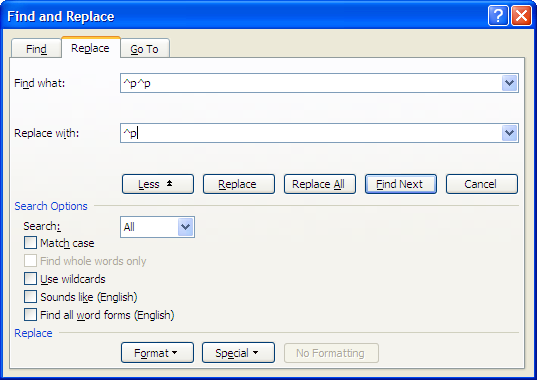Finding and Replacing in MS Word
Find and Replace, used intelligently, can save an awful lot of time and is really worth getting acquainted with. QuarkXPress and Word both have extensive capabilities, but I’ll deal with MS Word first.
Actually, Find and Replace is one of the better features of MS Word. I consider myself pretty decent on it, but there’s far more functions in the Help screens than I ever use. The important thing to bear in mind is that you can find and replace things far beyond letters, numbers and words. In addition, I would recommend doing all your finding and replacing in Word as, in terms of working on copy, the functions are more powerful than the equivalent ones in Quark.
Anyway, here’s the box. The full functions are revealed when you press the ‘more’ button.

The non-keyboard elements you can search for are all located in the ‘special’ button and enter search terms in the relevant box, usually in the form of the ‘^’ symbol followed by a single letter. For example, ‘^p’ is the term for a paragraph mark (i.e a carriage return).
Some standard fixes
There are three find and replace functions I do on any new document. I actually have macros set up to do these on individual buttons on my toolbar. How to do macros is a bit beyond the scope of this post, but this guide on about.com is pretty good.
- Replace all double spaces with single ones
There shouldn’t really be any double spaces at all in a document. Many people believe there should be a double space after a full stop, although this is typographically incorrect. I believe it’s something people were taught to do in the days of typewriters. (A double space looks particularly horrible in a fully justified column.) - Replace hyphens with en dashes
Another common typographical mistake. To avoid getting rid of genuine hyphens, enter spaces on either side of the hyphen and the dash in the find and replace box. (If your house style is to use em dashes, then the space either side of the em dash isn’t necessary.) - Get rid of instances where a space follows a paragraph mark
This won’t appear to be that important, but it will make more sense when you read the example below. In MS Word, you’re replace ‘^p[space]’ with ‘^p’ in the find and replace box.
A typical problem
Sometimes — usually the result of putting text through too many clipboard functions or converting formats too many times — you get a Word document where every line ends in a carriage return. Namely, when you show the hidden formatting, it looks like this:

This would obviously play havoc with formatting and I expect many people have been reduced to fixing this line-by-line. The good news is that there’s a straightforward fix for this. The approach is an example of the lateral thinking you sometimes need when faced with similar problems.
Okay here’s the fix. From looking at the copy, each paragraph proper is separated by two paragraph marks (the invisible ¶ symbols). Firstly, I’d recommend running the three find and replaces explained above.
As we’ve seen, these non-printing characters are searchable. Selecting the paragraph mark option twice from the ‘special’ menu will give you the codes ‘^p^p’ in the find box. You then need to replace this with a character (any character) that you’re confident doesn’t appear in the document. I usually use the dollar symbol, although US and Australian readers may wish to use something else. When you press replace, everything may turn a bit scary, but don’t worry.
You can then replace every single paragraph mark with a space. Once you’ve done that, change the new character you’ve introduced back into a paragraph mark (I recommend using a single paragraph mark, as paragraphs should really be separated by setting a distance in the paragraph formatting box). And there you go. So, to summarise:
- Replace all instances of two paragraph marks with an unusual character, such as $, # or {
- Replace all single paragraph marks with a space
- Replace the new character you’ve introduced with a paragraph mark.
Try this out yourself to experiment — you’ll soon get the idea.
What can I do?
to make a document created in WordPerfect, then edited in WORD 95, then opened in WORD 2003
to play nicely with bulleted lists?
The document I am receiving and opening with WORD 2003 turns the bullets into $ symbols. Since the formatting still thinks its a list, I cannot do a find and replace.
What you might be able to do is highlight a bulleted list, then right click and select ‘Select Text With Similar Formatting’. If you’re lucky, this will highlight all the bullet points in the document, allowing you to change the bullet character.